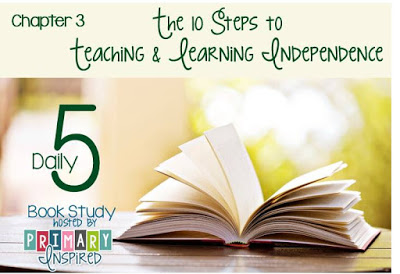I’m back with chapter 3 of The Daily 5 book study! This book has really been making me think and analyze how I want next year to go. Hmmmm…Decisions, decisions. But first, let’s take a look at this chapter. It’s being hosted by Whitney at The CraZy Schoolteacher.

The Sisters referred to these 10 steps as part of their core beliefs. But as you are about to see, this last core belief definitely needed their own chapter. THIS is what is going to get your through implementing Daily 5.
1. Identify what is to be taught.
Do this not only for yourself, but for your students too. If your students have prior knowledge/experience with D5, knowing that they are about to learn about Read to Self (as an example), they know what to expect. Even if they don’t know anything, being told what is going to be taught sets them up. The Sisters use “I”-charts as anchor charts for each of the choices. This helps show students what they will be learning about.
2. Set a purpose and create a sense of urgency.
This step helps students learn that “every moment of learning and practicing counts.” (pg. 37) The I-chart helps do this- list the reasons they will do each choice. One of those reasons is because it’s fun. Hello! Interest grabbed!
3. Record desired behaviors on an I-chart.
Each D5 choice will have its own I-chart. One thing the Sisters really cautioned on is don’t get caught up in telling students what not to do. Tel them what to do. Also, the Sisters learned that, while it’s nice having students help generate the list of what should be done at each choice, younger students in particular come up with almost too many suggestions. Many are the same as others or just too detailed and too numerous to discuss. As you are writing these out, you are explaining each one. Now they will provide the desired behaviors for us to list and explain. Also, if your know your students need a slower pace, start off with only one or two. Then with each subsequent practice session add one or two more. Easy!
4. Model most-desirable behaviors.
Have students do this. Easy! 🙂
5. Model least-desirable behaviors, then most-desirable behaviors again.
An awesome tip the Sisters gave- pick a student who you know is an attention getter/often off task type person to demonstrate this. By having this type of student show what not to do and then do it correctly, they get to be center of attention and they start developing that muscle memory that’s going to help with being independent later. Makes sense! Always refer to the I-chart to show how the student is/is not following it.
6. Place students around the room.
You place them the first few times. And place them in a different place each time. This way, students learn where they can go and they start to figure out which places will help them work the best. When placing students during the practice time, do the ones most likely to lose stamina last so that they don’t get squirmy before you can get your kiddos set up. Makes sense! (Don’t know about y’all, but sometimes being reminded of simple tips/strategies is a must for me with all the other “stuff” we gotta remember!)
7. Practice and build stamina.
We need to let go and let them do it. Let them practice. Keep track of how long students can demonstrate those desirable behaviors on the I-chart. Showing their stamina on a chart shows how they improve. It will also show that some days may not be good. But they should always try again the next time.
8. Stay out of the way.
Okay. I confess. This would be hard for me. I would be so tempted to circle the room and look at what the kiddos are doing. Don’t. Do. It. You won’t be doing that when it’s time to bring in small groups. So why do it now? Go sit somewhere out of the way. No eye contact. No nodding your head. Nothing. But be aware of what the students are doing. You need to look for those students who are going to have the lowest stamina as they will determine when you stop the group.
9. Use a quiet signal to bring students back to the gathering place.
When we see a student has no more stamina, it’s time to give that quiet signal that I’m sure you’ve already introduced to get their attention. Making sure it’s quiet and not overly loud keeps the kiddos on the calm side. Don’t say anything about how the students did. Just get them back to the whole group area.
10. Conduct a group check-in; ask, “How did it go?”
Go down the list of expected behaviors on the I-chart and ask the students how they did on each one. Have them show fingers in front of them to model this:
1- below standard
2- approaching standard
3- meeting standard
4- exceeding standard
This will help students think about how they did and start to set goals for the next round of D5. The Sisters pointed out too that students do not need to vocalize anything. Remind them that this is for themselves to think about rather than sharing it. We can see how they did on their fingers. Thank you for this! Also, for those students who show fingers that in no way reflects how they did, ignore them. They are usually seeking attention. If the behavior continues, you might need to do a one-on-one discussion with that student. Again, thank you for that tip!
After check-in, you decide if your students are okay with another round of practice or if they need to move on to something else. Check-in later evolves to students telling what their new goals are. Also, it’s a good time to review the I-charts as needed. You decide. 🙂
Well there you have it! Needless to say I highlighted. A lot. And I’ll be going back to jot down some notes. Or a lot. I tend to overdo the highlighting and note taking thing. It’s a quirk of mine. Lol! If you click on the picture above, you’ll be at Whitney’s post and the link-up to read other great teachers’ thoughts on this chapter. Let me know what you think below.
Happy Teaching!


















